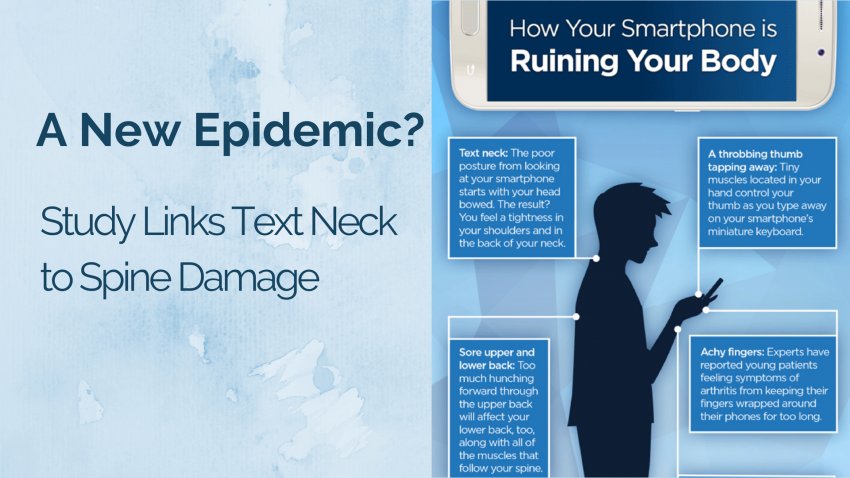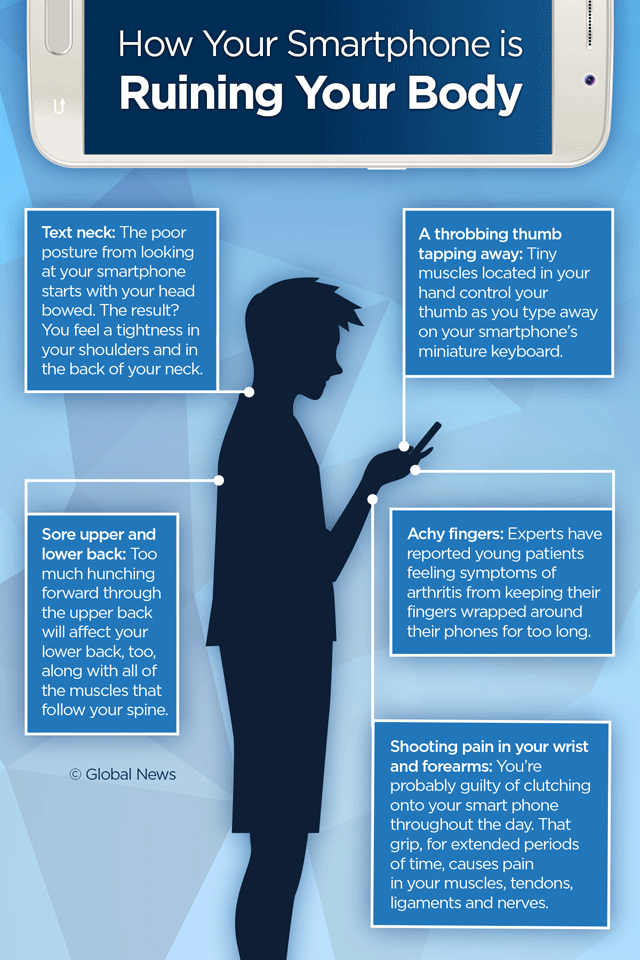View basket (0 items $0.00)

A New Epidemic? Study Links Text Neck to Spine Damage
Do you spend your day hunched over a laptop or with your head bent at an unnatural angle while texting or checking email or Facebook updates on your smartphone? If so, pause for a second, sit up straight, and take notice: you may be setting yourself up for chronic neck pain and even spine damage.
How Text Neck Undermines the Health of Your Spine
The constant slouching linked to poor sitting posture or smartphone use can lead to loss of the natural curve of the neck, according to a study in Surgical Technology International. This in turn leads to increased stresses on the upper spine and neck, which may lead to early wear, tear, degeneration, and possibly surgery. (1) (2)
It’s all about the cumulative effect. While texting with your head bent over your smartphone won’t hurt you in the short run, over the long term it will. Most of us spend an average of two to four hours a day with our heads tilted over smartphones, tablets, or laptops, the study’s authors estimate. Cumulatively this is 700 to 1400 hours a year of excess stresses on the cervical spine. According to the study’s authors, it is possible that a high school student may spend an extra 5,000 hours in poor posture due to cell phone and computer use.

This puts a lot of stress on the cervical spine, which may result in premature wear and tear and accelerate degenerative processes such as arthritis or intervertebral disc degeneration.
Benefits of Yoga: More than Posture Improvement
As we all know, technology is here to stay, so what can we do? First of all, increase your awareness of the importance of good posture. When you use your smartphone, be sure to sit upright with a neutral spine. Avoid spending hours each day hunched over a smartphone, tablet, or laptop.
It is also very helpful to focus on strengthening the main posture support muscles and increase spinal flexibility through yoga. Research has shown that therapeutic yoga for posture can be very effective and in addition, offers stress management. Yoga has the potential not only to address back pain and joint issues, but also to lead to more energy and vitality as energy flows more freely in the body.
When standing with good posture, the average adult’s head weighs approximately 10 to 12 pounds. But due to gravity, the more the neck moves forward, the heavier the head becomes and the more pressure is put on the cervical spine. According to the authors of the study, if the neck is bent at 15%, the weight of the head increases to 27 pounds, and if the neck is bent even further, say 60%, the weight of the head becomes a whopping 60 pounds! No wonder these positions cause fatigue, pain and can lead to early degenerative wear.
What is Good Posture?
So what is good posture? Good posture is the position where the least strain is placed on supporting muscles, the head is upright, and the shoulders are back and relaxed. We all know that correct posture is better for the spine and back. The authors write, “In proper alignment, spinal stress diminished.” They conclude, “It is the most efficient position for the spine.”
There are many benefits associated with better posture. Not only does it influence your body language making you look more poised and confident, but studies have shown that good posture even elevates serotonin and testosterone levels while reducing cortisol, a hormone associated with stress. Studies have even shown that poor posture affects long-term mortality, substantially increasing the risk of dying from both heart disease and lung diseases.
Yoga Poses for Better Posture
Yoga poses that are particularly useful for improving posture use the muscles and joints that are associated with bad posture: shoulders, abdominals, and neck. These practices help restore strength and flexibility to the spine as well as opening up the chest and heart area and improving or even reversing bad posture. People who take care of their posture not only feel better and prevent chronic pain from developing but are less likely to lose balance and function as they become older.
Resources:
1. https://www.scinapse.io/papers/53370736#fullText
2. https://slate.com/technology/2014/11/new-study-by-spine-surgeon-kenneth-hansraj-shows-texting-is-bad-for-your-spine-but-we-already-knew-that.html
Featured Courses










